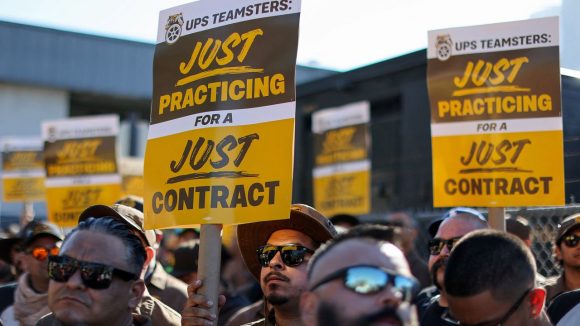There’s no good writing, only good rewriting.
I wrote a lovely blog about the possibility of a UPS strike.
Then they settled!
___
I should have remembered my interview with James Hoffa, Jr., in 2006 about the “impending” UPS strike. Hoffa was head of the Teamsters Union. He told me “don’t worry about it.” There are 23 Locals, and you must satisfy them. Then you can make a national deal.
And there was no strike.
This time around, the key issue was how do you deal with part-time people who are increasingly part of the UPS workforce. In previous negotiations, they were an after-thought, but since the pandemic and a chronically tight labor market in the U.S., despite the Fed’s desire to cause a recession and promote unemployment and undercut wage increases, there are still loads of jobs to fill and wage pressure.
In the end, UPS and the Union were realistic. Wages for part-timers rose almost 30% which showed an awareness by both parties that many folks are just not searching for 40- to 50-hour work weeks. The pandemic has changed the outlook, at least for now, of potential workers. Childcare trims work hours, especially with less than half of parents being married. Many potential UPS workers are going to school while working at the company. Others prefer two jobs for variety and scheduling.
It appears the Teamsters also took a realistic attitude toward part-time work, seeing it as an important component of the workforce, not a plot by the company to limit their workers’ paychecks. For full-time people, part-timers are no longer a threat. They are potential full-time employees, and they keep the company solvent during worker shortage periods, which are not going away soon.
For UPS, the part-time issue is an opportunity and a headache. It is easier to find part-timers, but there is more turnover. Theoretically, they are cheaper, but the constant turnover certainly diminishes the quality of service. Worker loyalty has to suffer, but if this is all that is available you make it work.
At Graff-Pinkert we used to employ a full-time electrician, but during the pandemic we let him go. When business picked up, I asked him to be a “gig worker,” and he happily agreed. We offered a high hourly wage but no benefits. Meanwhile, he had started his own business as a subcontractor for Chicago independents refurbishing homes. He never did like working Mondays at Graff-Pinkert, so now he makes his own hours.
We know machining firms that have tailored their hours to the needs of their skilled people. This approach seems to work for all parties. “One shoe fits all” is yesterday’s approach.
I doubt UPS is that flexible, but the new contract appears to signal company and the Union are acknowledging the times. If Amazon can live with the “nomad worker,” UPS can make its peace with part-time America.
Question: What flexible schedule options do you think would make sense at your company, if any?


1 Comment
Lloyd – This will not answer your question, but I needed to give UPS a shout-out. Starting in HS and through college I worked part-time at UPS. I began loading package cars (trucks) to pulling packages from the conveyor belt and placing them into the proper trailer. I was a Teamster, and was eventually promoted to a position supervising Teamster workers. The work was hard but the wage and benefits were great. I would not trade that experience for any other. More than any college accomplishments, my UPS experience enabled Warner & Swasey to see something in me which ultimately led to my machine tool career. I am thankful that full-time UPS employees no longer see part-timers as a threat. As Jimmy Casey, the founder of UPS said, “One measure of your success will be the degree to which you build up others who work with you. While building up others, you will build up yourself.”